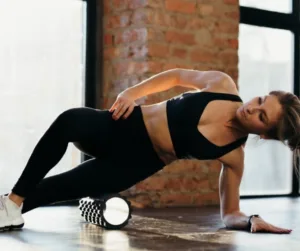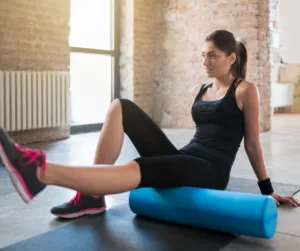So you crushed your workout! You pushed yourself, challenged your limits, and left it all on the gym floor (or the track, or the yoga mat). But your work isn’t quite done yet. What you do after your workout significantly impacts your recovery, results, and how you feel the next day.
Get the most out of your training efforts by incorporating these practices into your post-workout regimen.
Whether you’re looking to improve your range of motion, alleviate soreness, or boost recovery time, Nick Clayton, M.S., M.B.A., C.S.C.S.,*D, R.S.C.C., the Personal Program Manager for the National Strength and Conditioning Association, suggests doing these six things after you train.
Here are 6 key things to prioritize after your sweat session:
1. Cool Down and Stretch: Don’t just abruptly stop after your last rep. Dedicate 5-10 minutes to a cool-down that gradually brings your heart rate down and prevents blood from pooling in your veins. Light cardio like walking or jogging on the treadmill, followed by static stretches that hold each pose for 30 seconds, can help loosen tight muscles and improve flexibility.
2. Replenish Fluids: Exercise leads to fluid loss through sweat. Aim to rehydrate with water or a sports drink containing electrolytes, especially if your workout was intense or lasted longer than an hour. A good rule of thumb is to drink 16-20 ounces of fluids for every pound lost during exercise.
3. Refuel with the Right Nutrients: Your muscles are primed to absorb nutrients after a workout. Consume a snack or meal within 45 minutes of finishing your exercise. Focus on a 4:1 ratio of carbohydrates to protein. Carbs replenish glycogen stores, your body’s primary energy source, while protein helps repair and rebuild muscle tissue. Examples include yogurt with fruit and granola, a turkey sandwich on whole-wheat bread, or a protein smoothie.
4. Shower or Take a Bath: A cool or lukewarm shower can help regulate your body temperature and rinse away sweat and dirt. Some research suggests a cold shower might also reduce muscle soreness. If you prefer a bath, Epsom salt baths can be particularly soothing for tired muscles.
5. Prioritize Rest and Recovery: Give your body the time it needs to rebuild and repair itself. Schedule rest days throughout your workout week, and incorporate activities like yoga or light walks to promote recovery. Getting enough quality sleep (7-8 hours per night) is also crucial for muscle growth and overall well-being.
6. Listen to Your Body: Pay attention to how you’re feeling. If you experience excessive pain or discomfort, it might be a sign of overtraining or an injury. Don’t hesitate to take a break or adjust your workout routine to allow your body the rest it needs.
Check Out Our List Of The Best Supplements For Building Muscle, Shredding Muscle, Recovery, And Great Health, and Wellness Products! Purchase ifbnewsfeed.org‘s apparels Here: ifbnewsfeed.org
 6 Additional Key Things to Do After Your Workout for Optimal Recovery
6 Additional Key Things to Do After Your Workout for Optimal Recovery
-
Roll
We can’t promise it’ll be painless, but performing self-myofascial release techniques using a foam roller can help improve flexibility, increase blood flow and circulation, and break up “knots” in soft tissue. It’s a good thing to do both pre-and post-workout.
You get foam roller at affordable prices at: High Density Foam Roller for Back Pain Legs and Muscles Extra Firm with Online Instructional Video (Solid Purple, 18-Inch)
“After your workout, use a foam roller before you do your stretches,” he advises. “While it’s similar to stretching, a roam roller affects more of the fascia connection. [And] breaking up a superficial layer of tissue enables you to get a deeper stretch.”
-
Cool Down
Don’t make a beeline for the exit after your last set. Allowing the body to cool down after you exercise can prevent blood from pooling in the veins.
“I encourage athletes to cool down for five minutes, doing light cardio to flush out any metabolic waste products,” says Clayton. “Keep your cool-down activity specific to what you just exercised. So, for example, if you do an upper body workout, then use the row machine to target the area you just damaged.”
-
Stretch
According to Clayton, a post-workout stretch is especially important for those who have bulked up and lost flexibility and range of motion.
“I don’t recommend stretching for people who are already flexible, but that’s typically not the case with bodybuilding or heavy strength training,” he says. “Done properly, stretching can help the nervous system relax and recover along with benefiting the muscles.”
Work your stretch too hard and you’re likely to pull or strain something; dog it and you’re wasting time. The key to a good stretch is to find that balance between discomfort and pain.
“Stretch to where it’s uncomfortable but you’re not hurting,” Clayton advises. “I suggest that my clients focus on diaphragmatic breathing during their stretching.”
-
Rehydrate
The body sweats to cool itself down as you’re blasting through a grueling workout. Without refilling the fluids you’re losing through sweat (and urine), you’ll get dehydrated.
“Sweating out 2% of your bodyweight will translate to negative effects on performance,” Clayton says. “You’ll notice the effects most during cardio. So if running a seven-minute mile is relatively easy for you, when you’re dehydrated, the body and heart will be working harder to achieve that goal.”
Proper hydration regulates body temperature and lubricates the joints; it can also help stave off constipation. Thirst is typically a delayed indicator that you’re dehydrated. But how can you tell for sure? Use the pee test.
“If your urine is clear or light yellow, like a lemonade, you’re in good status,” Clayton reveals. “When it’s yellow or bright yellow, that’s when dehydration is creeping in.”
 Wrapping Up
Wrapping Up
By incorporating these practices into your post-workout routine, you’ll optimize your recovery, minimize muscle soreness, and set yourself up for continued progress on your fitness journey. Remember, consistency is key!
More About Best Band Exercises You Should Consider Targeting Weak Muscle Groups Contents
- Try Out “This Resistance Bands Workout” To Build Up A Desired-Shredded Chest
- Bands vs Dumbbells: Should You Train “Strength” With Resistance Bands Or Dumbbells?
- Training Resistance Band Workouts Are Everywhere – “But Do They Really Work”?

- A1Supplements.com – America’s Favorite Supplement Store.
- Shop Optimum Nutrition Energy: Anytime & Pre-Workout
- A1Supplements.com – Lose Fat, Gain Muscle
- Dive Into Our Bestselling SUPs
For More News And Daily Updates, Follow IFBNewsfeed.Org™🇺🇸 on Facebook, Twitter, and Instagram. Comment, Like, And Share With Everyone Who May Need To Be Updated With The Most Recent Fitness/Bodybuilding/Powerlifting And CrossFit News.








